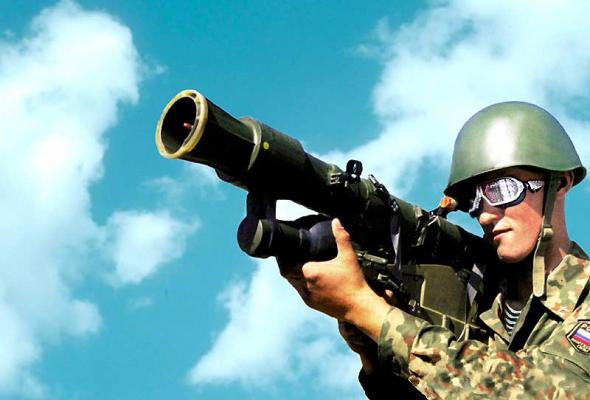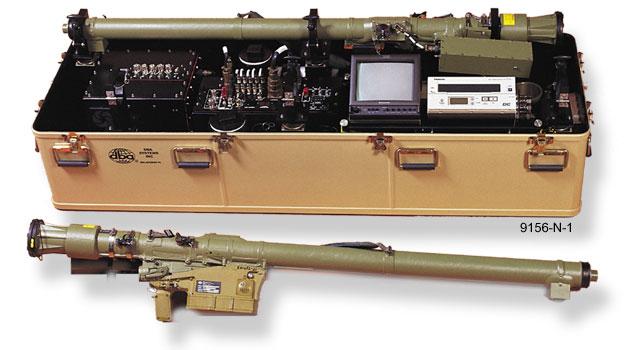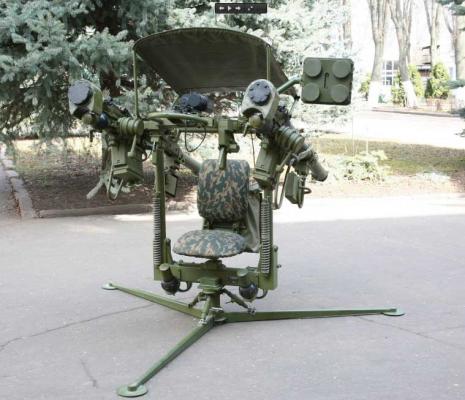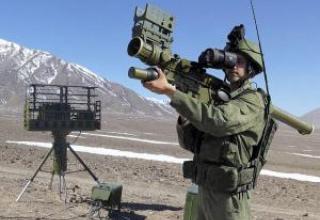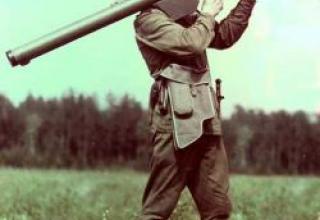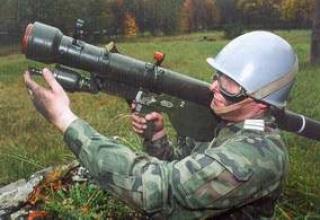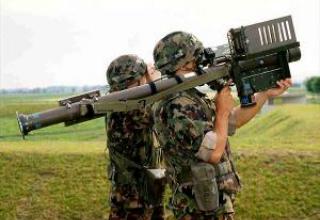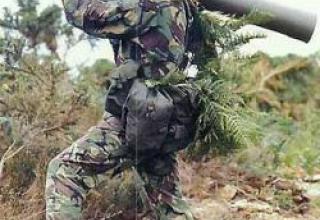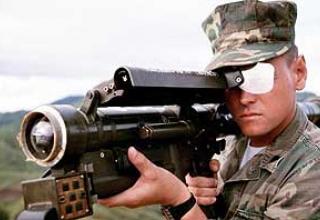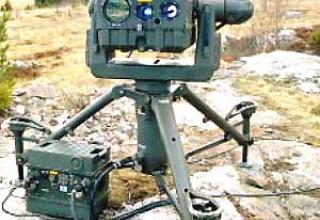The development of a new portable SAM system "Needle" was carried out in accordance with the Decree of the CPSU Central Committee and the USSR Council of Ministers dated February 12, 1971 and taking into account the initiative proposals of the Heavy Defence Ministry.
When creating the complex, the tasks were set to improve efficiency in the areas of provision:
- Thermal CNS is protected against optical noise traps fired by enemy planes and helicopters;
- more effective at hitting a target with a direct hit from an SAM;
- greater range and effectiveness in firing at targets on counter courses;
- a more reliable determination of the nationality (identification) of the target to exclude the firing of their aircraft;
- pre-targeting anti-aircraft gunners at approaching enemy aircraft and helicopters by tactical air defense control points.
The head designer of the portable SAM system "Igla" (9K38) was determined to be the DOE MOP (Chief Designer - S.P. Undefeated), and the thermal GSN was created by LOMO MOP (Chief Designer of the head - O.A. Artamonov).
Cooperation between the developers of the complex, mainly corresponding to the one that participated in the creation of portable SAMs "Arrow-2" and "Arrow-3" was complemented by the Research Institute of Measurement Instrumentation MRR in terms of the development of ground radar requisitioner (Chief Designer of the requisitioner - Yu.V. Moiseev) and the Central Design Bureau of Hardware Engineering (CKBA) MOP in order to create a portable electronic tablet (Chief Designer of the tablet - V.G. Rosenthal).
An upgraded version of the 9K338 "Igla-S" complex is currently being proposed.
Composition:
It is part of the complex:
- 9M39 missile;
- launch tube 9P39;
- launch mechanism 9P516 with built-in ground radar 1L14;
- portable electronic tablet 1L110.
Requester 1L14 was borrowed from Needle 1 complex.
The main difference between the 9M39 missile and the 9E410 two-channel homing head. The homing head has a high sensitivity and is able to distinguish between true and false targets under conditions of artificial interference in the infrared range. For this purpose, the Homing Head has two channels - main and auxiliary. Photoreceiver of the main channel is a photoresistor based on an austenitic indium, cooled to -200 ° C. The cooling system of the photoreceiver is the same as that of "Needle-1". The maximum spectral sensitivity of the main channel photoreceiver is in the range of 3.5-5 μm, which corresponds to the spectral density of jet engine gas jet radiation. The auxiliary channel photoreceiver is an uncooled sulfur lead-based photoresistor, which maximum spectral sensitivity is in the range of 1.8-3 µm, which corresponds to the spectral radiation density of interference type false thermal targets. The switching system of GSN 9E410 takes a decision according to the rule: if the signal level of the photo receiver of the main channel is higher than that of the auxiliary channel, it is a target, if the opposite - interference.
In order to improve the directional dynamics of the SAM at the predicted meeting point with the aim of thermal bi-spectral CNS 9E410, an additional scheme was introduced, forming a command to turn the missile at the initial flight section, and an electronic switch of modes "inhale-to-attack". Miniature pulsed solid-fuel engines were installed in the rocket's steering section to ensure a postlaunch turnaround.
In the combat unit 9M39 (similar to needle-1) explosive substance with increased blast effect was used. The ZRG fuse had an induction sensor (vortex generator), which ensures BC explosion when the missile passes near the metal cover of the target. In a direct hit, the BC was detonated by a duplicate contact fuse. A tube with an explosive substance was inserted into the fuse to transfer the detonation from the BC charge to the charge of the explosive generator first installed on the SAM to detonate the remaining fuel of the missile's marching engine.
The new features of the "Needle" complex, compared to the portable SAM system "Needle-1", were considered:
- the ability to fight oncoming and overtaking courses with modern and promising air targets in the conditions of their application of artificial thermal interference;
- increased target range on counter courses due to increased pre-launch sensitivity of the homing head of the SAM;
- availability of a single launch mechanism, which ensured the launch and pointing of both needle and needle-1 man-portable air defense systems.
In the process of creating the Needle complex, a number of complex technical problems were solved, such as:
- ensuring noise immunity through target selection against artificial interference by applying a brand new dual-channel homing optical head with a logical selection unit of true targets against the background of interference;
- doubling the pre-launch sensitivity of the homing head of the SAM system in comparison with the Igla-1 system, which made it possible to ensure an acceptable area of engagement of targets on counter courses and ensure effective firing of targets before they perform their combat mission;
- creation of signal preamplifiers from photo receivers placed on the rotating rotor of the coordinator, which, together with other activities, ensured increased sensitivity of the CNS;
- the creation of low-accuracy, silent collectors and current receivers to transfer signals from photo-receivers to the electronic unit of the homing head, which also contributed to the sensitivity of the CNS;
- the creation of a deep cooling system for the rotating photoreceiver, which also improved the sensitivity of the CNS;
- providing acceptable protection for the CNS against background noise when the sensitivity of the head is increased;
- creation of a single trigger for Needle and Needle-1 complexes without increasing its mass;
- ensuring the required accuracy of guidance and displacement of the missile impact point grouping center through the use of information from the homing head with a pulse circuit of signal processing from the target, which made it possible to carry out a spatial selection of the true target and increased effectiveness of its defeat by hitting the shrapnel flow into more vulnerable, as compared with the nozzle part, elements of the target structure.
The use of the new thermal GSN made it possible to use an elegant needle-like construction rather than the "tripod" used on the Igla-1 rocket to reduce aerodynamic resistance. This technical solution, which gave the name to the portable SAM, was proposed by the specialists of the Design Bureau even before the reports on the application of the aerodynamic "needle" on the American "Trident-1" rocket appeared in the press.
The complex provided defeat of air targets on counter and catch-up courses, firing at intervals of 0.3 s and more with thermal interference exceeding the total radiation power of the target up to six times. When shooting thermal interferences at counter and overtake courses by single or volleys (up to six in volleys), the average probability of target engagement of one ZUR 9M39 over the flight of the kill zone was 0.31 when firing towards the target and 0.24 when firing inhaler. In such interference conditions the "Needle-1" complex was practically inoperable.
The certain drawback of "Needle" complex, as well as of all previous modifications of domestic portable SAM systems, peculiar to foreign complexes of this class, was the fact that at angles between the axis of SAM homing head and direction to the sun less than 20° the rocket guidance to the target was practically not provided.
In the combat work of these complexes differed from the portable SAM system "Needle-1" was that the target designation from the developed for the complex "Needle" tablet 1L110 on wired communication lines of the CC could go to the anti-aircraft gunners on the indicator devices of the trigger mechanism of this complex, which accelerated the search and capture of targets. It was considered expedient to use the "Needle" system with the selector of true and false targets turned off when the SAMs are launched in the direction of the sun and with strong interference.
The main external difference of the needle SAM system was the expanding conical front part of the launch tube (see photo).
Later, mainly for the Airborne Troops, a version of the Igla-D man-portable airborne SAM system with a SAM system and a launch tube was developed, which was transported in the form of two sections connected before the combat application, thus improving the airborne airborne capabilities of the complex and ensuring its convenient transportation.
The unit has also been designed to provide two SAMs in the launch tubes for use in ground-based launchers and as weapons for helicopters.
To ensure the simultaneous use of two SAMs, a version of the Jigit turret system has been developed, where the gunner is placed in a rotating seat and manually points the launcher at the target.
In addition, a version of the Igla-N man-portable SAM system with a more powerful combat unit was developed. The weight of the complex increased by 2.5 kg. Due to a slight decrease in such indicators as the speed of hit targets on the oncoming and catch-up courses (up to 340 and 280 m/s respectively), the probability of hitting targets has increased by 25...50%.
Characteristics:
| Defeat zone, km: - in range (inhaling/attacking) - up and down - as defined in |
1..5,2/0,5..3,3 0,01..2,5/0,01..2 up to 2,5 |
| Probability of hitting a single ZUR fighter. | 0,45..0,63 |
| Maximum target speed (inhaling/attacking) m/s | 320/360-400 |
| ZUR flight speed, m/s | 600 |
| Mass of the rocket, kg | 10,6 |
| Weight of combat unit, kg | 1,17 |
| The length of the rocket, mm | 1574 |
| The diameter of the rocket body, mm | 72 |
| Mass of combat vehicles, kg: - at war - hiking |
17 18.8 |
| Time to transfer combat assets from camping to combat position, sec | not more than 13 |
| The reaction time, sec | not more than 5 |
| Operating temperature range, deg C | between -40 and +50 |
| Self-liquidation time, sec | 14-17 |
Testing:
During the war with Iran, Iraq used HOT missiles, launching them from ground armored vehicles as well as helicopters. In the 1980s. "HOT was used in Lebanon by Syrians who destroyed several Israeli tanks such as Merkava. The complex was used by multinational forces during Operation Desert Storm.
Sources:
- Зенитные ракетные комплексы ПВО СВ. Техника и вооружения №5-6.99
- Вестник ПВО
- Russian Missile Systems - www.wonderland.org.nz
- http://www.kbm.ru/ru/production/pzrk/pupzrk/
